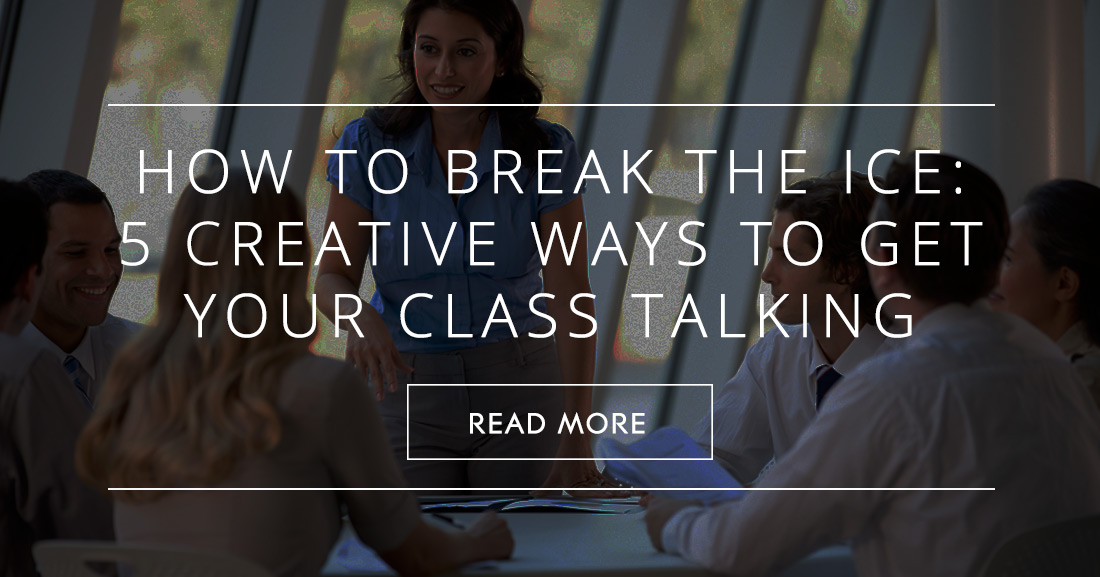Break the Back-to-School Ice! 10 Fun Icebreakers for the Beginning of the Year


They are even more important if your students do not know one another well either. Depending on how your school organizes its classes, you may use these types of activities primarily at the beginning of the school year. You can also adapt icebreakers into activities to use when starting new topics. It is sometimes easier for students to share their ideas if they know the rest of the class will have to share theirs too.
Here are some fun icebreakers you can do with almost any class.
Learn The Names
In order to learn students’ names, you can conduct an activity where students take turns saying their name. You can make this more challenging by having students say the name of the last student to speak or even the names of all the students who have already said their name before saying their own name. To make it more interesting and to learn a little more about your class, ask students to include something specific such as their favorite cereal, color, sport, or movie. By the end of the activity you should try your best to say every student’s name. If students are learning the names of their classmates for the first time, conduct some other name activities for practice. For one activity, have students stand in a circle, on a student’s turn he should say a word or sentence related to whatever prompt or topic you choose, and then call out the name of a classmate to go next.
Find Someone Who...
If students know one another’s names, get them talking about some other topics by having them play “Find Someone Who ~” where students ask and answer questions based on pictures or phrases to find someone for each question who can answer “Yes.” The model question for this activity could be “Do you like ~.” or “Do you have ~.” After five to ten minutes, depending on the number of questions students have to ask, have everyone sit down and call on students to read some of the answers, for example “Ben likes soccer.” this way the class can learn more about individual students. Try to encourage students to give sentences about people who have not yet been mentioned. This gives everyone the opportunity to share something.
Talk and Remember
Another activity gets students talking with the people seated around them. Have students talk to the person to their right about hobbies for instance. After a minute or two have students turn to the person to their left and talk about another topic. You could also do this as a mingling exercise where students have a limited amount of time to exchange information before moving on to the next person and conversation topic. Be sure to ask some students things they learned about their peers at the end of the activity so that they try their best to remember the conversations they had.
What's Important
If your class is quite small you may also consider having students think about the three things they would take with them to a deserted island and then share why they chose one or all of those things. This is an excellent way of getting to hear about what is important to your students and how they are able to organize their thoughts. If your class is larger, you can conduct the same activity in groups which is good for getting students talking with one another but will exclude you for most of the activity. Another similar group activity is to have students write down the first word that pops into their head when they hear you say a certain color. Students can then discuss why they chose certain words in their groups or just have the student with the most unusual choice explain his choice. After a few minutes give them another color to think about and discuss. Groups should present the class with a brief summary of their discussions towards the end of the lesson.
Three Adjectives That Describe You
For introductions, you could also have students choose three adjectives to describe themselves. Perhaps a the end of the year have students fill in adjectives for all their classmates, nothing mean spirited, and give students a summary of what their classmates said about them in the last lesson. This should give students some positive reinforcement and point out their personality strengths. It may be interesting to compare these with the adjectives students chose to describe themselves too.
Icebreakers are excellent because they give students the opportunity to share things about themselves and learn about their peers. These activities often get students moving or thinking creatively. They can be lots of fun and dissolve any tension or nervousness there might be in your classroom. It is important that students be able to interact with one another easily because learning English is all about communication. Students will need to be comfortable sharing ideas with the class and talking with other students in groups or in pairs on a regular basis.
View our "Warmers and ice-Breakers" section here.
Do you have any other creative warmers and ice-breakers? Please share!